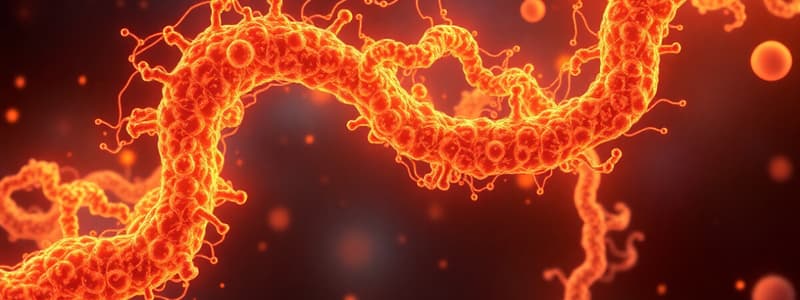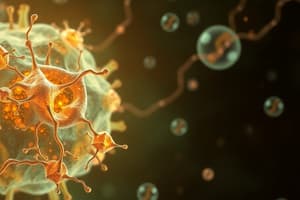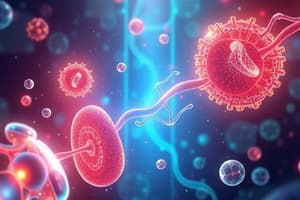Podcast
Questions and Answers
What is the primary focus of pharmacodynamics?
What is the primary focus of pharmacodynamics?
- Monitoring drug concentrations in the body
- Therapeutic use of drugs in patient populations
- The study of how the body processes drugs
- The drug's effects on cells and tissues (correct)
Which type of therapy is aimed at providing relief from symptoms without curing the illness?
Which type of therapy is aimed at providing relief from symptoms without curing the illness?
- Supplemental therapy
- Maintenance therapy
- Palliative therapy (correct)
- Prophylactic therapy
What is the primary function of hepatic metabolism?
What is the primary function of hepatic metabolism?
- To eliminate drugs through renal excretion
- To metabolize drugs into inactive metabolites only
- To biochemically alter drugs, potentially activating them (correct)
- To enhance the solubility of all drug compounds
Which enzyme system is primarily responsible for drug metabolism in the liver?
Which enzyme system is primarily responsible for drug metabolism in the liver?
What characterizes drug tolerance?
What characterizes drug tolerance?
What does the term 'half-life' refer to in pharmacokinetics?
What does the term 'half-life' refer to in pharmacokinetics?
What does the term 'therapeutic index' refer to?
What does the term 'therapeutic index' refer to?
What is a consequence of physiological dependence on a drug?
What is a consequence of physiological dependence on a drug?
Which of the following statements about drug excretion is correct?
Which of the following statements about drug excretion is correct?
What happens when the peak blood level of a drug is too high?
What happens when the peak blood level of a drug is too high?
What is the main focus of pharmaceutics in pharmacology?
What is the main focus of pharmaceutics in pharmacology?
Which phase of drug activity is primarily concerned with the body's processes affecting the drug?
Which phase of drug activity is primarily concerned with the body's processes affecting the drug?
Which route of drug administration provides 100% bioavailability?
Which route of drug administration provides 100% bioavailability?
What is a key factor determining the distribution of a drug in the body?
What is a key factor determining the distribution of a drug in the body?
Which factor can increase the risk of drug toxicity in the context of protein binding?
Which factor can increase the risk of drug toxicity in the context of protein binding?
What term describes the portion of a drug that is active and not bound to proteins in the bloodstream?
What term describes the portion of a drug that is active and not bound to proteins in the bloodstream?
Which drug administration route involves absorption through the mucosa of the stomach or intestine?
Which drug administration route involves absorption through the mucosa of the stomach or intestine?
What is the primary concern of pharmacodynamics in drug therapy?
What is the primary concern of pharmacodynamics in drug therapy?
Flashcards
Pharmaceutics
Pharmaceutics
The study of how various drug forms affect the body's response to medication.
Dissolution
Dissolution
The process where solid drug forms dissolve and are absorbed into the body.
Pharmacokinetics
Pharmacokinetics
The study of what the body does to a drug from absorption to elimination.
Bioavailability
Bioavailability
Signup and view all the flashcards
Distribution
Distribution
Signup and view all the flashcards
Protein Binding
Protein Binding
Signup and view all the flashcards
Pharmacogenomics
Pharmacogenomics
Signup and view all the flashcards
Pharmacodynamics
Pharmacodynamics
Signup and view all the flashcards
Metabolism (Biotransformation)
Metabolism (Biotransformation)
Signup and view all the flashcards
Half-life
Half-life
Signup and view all the flashcards
Steady State
Steady State
Signup and view all the flashcards
Onset of Action
Onset of Action
Signup and view all the flashcards
Pharmacotherapeutics
Pharmacotherapeutics
Signup and view all the flashcards
Adverse Drug Reaction
Adverse Drug Reaction
Signup and view all the flashcards
Therapeutic Index
Therapeutic Index
Signup and view all the flashcards
Study Notes
Housekeeping
- Registration
- Review of syllabus and expectations
- Kaplan review
- Importance of learning generic drug names for the NCLEX exam
- Questions
Pharmacological Principles
- Pharmaceutics
- Pharmacokinetics
- Pharmacodynamics
- Pharmacogenomics
- Pharmacotherapeutics
Pharmaceutics
- Study of how various drug forms influence the way a drug affects the body
- Dissolution
- SR (sustained release)
- SA (sustained action)
- CR (controlled release)
- XL (extended release)
- XT (extended time)
- Thin-film
Phases of Drug Activity
- Pharmaceutical phase
- Disintegration and dissolution of the drug
- Pharmacokinetic phase
- Absorption, distribution, metabolism, excretion
- Pharmacodynamic phase
- Drug-receptor interaction
Pharmacokinetics
- Study of what the body does to the drug
- From the time the drug is administered until the parent drug and metabolites leave the body
- Absorption
- Distribution
- Metabolism
- Excretion
Absorption
- Bioavailability
- Bioequivalent
- First-pass effect
- Enteral route
- Sublingual
- Buccal
- Oral
- Nasogastric, g-tube, j-tube
- Rectal
- Parenteral route
- Intradermal
- Subcutaneous
- Intravenous (IV) - 100% bioavailability
- Intramuscular
- Intrathecal
- Intra-articular
- Intra-arterial
- Topical route
- Transdermal route
- Inhalation route
Distribution
- Transport of a drug by the bloodstream to the drug's site of action
- Drugs distributed first to areas with extensive blood supply
- Heart, liver, kidneys, and brain
- Protein binding
- Albumin is the most common blood protein and carries most protein-bound drug molecules
- If a drug binds to albumin, only a limited amount is unbound
- Unbound portion or "free" drug is active
- Certain conditions lead to low albumin, increasing the chance of toxicity
- Drug interactions can occur if drugs fight to bind
- Blood-brain, blood-placenta barriers
Metabolism
- Also referred to as biotransformation
- Biochemical alteration of the drug into any of the following:
- Inactive metabolite
- More soluble compound
- More potent metabolite (as in the conversion of an inactive prodrug to its active form)
- Less active metabolite
- Hepatic metabolism
- Cytochrome P-450 enzymes (AKA microsomal enzymes)
- Lipophilic ("fat loving")
- Hydrophilic ("water loving")
- Substrates - drug molecules that are targets for enzyme
- Enzyme inhibitors (meds delay metabolism) - e.g., erythromycin
- Enzyme inducers (speed up metabolism) - e.g., phenytoin
- Cytochrome P-450 enzymes (AKA microsomal enzymes)
Excretion
- Elimination of drugs from the body
- Primary organ responsible is the kidney
- Liver and bowel also play a role
- Renal excretion
- Biliary excretion
Other Pharmacokinetics Terms
- Half-life
- Steady state
- Onset of action
- Peak effect
- Duration of action
Pharmacodynamics
- The study of what the drug does to the body
- Mechanism of drug actions in cells and tissues
- Therapeutic effect
- Goal of drug therapy
- Mechanism of action (MOA)
- Receptor interactions
- Enzyme interactions
- Nonselective (chemo)
Pharmacotherapeutics
- Clinical use of drugs to prevent and treat diseases
- Desired therapeutic outcomes are patient-specific, established in collaboration with the patient
- Outcome goals need to be realistic
- Types of Therapy
- Acute
- Maintenance
- Supplemental
- Palliative
- Supportive
- Prophylactic
- Empirical
- Monitoring
- Therapeutic action
- Beneficial effects
- Adverse drug event
- Adverse drug reaction
- Toxic effects
- Therapeutic index (low = small gap between therapeutic and toxic)
- Drug concentration
- Patient condition
- Tolerance
- Dependence
- Physical dependence
- Psychological dependence
- Drug interactions
- Additive effects (1 + 1 = 2)
- Synergistic effects (1 + 1 > 2)
- Antagonistic effects (1 + 1 < 2)
- Incompatibility (1 + 1 = 0)
- Other drug effects
- Teratogenic
- Mutagenic
- Carcinogenic
- Ten Rights of Medication Administration
- Right drug
- Right dose
- Right time
- Right route
- Right patient
- Right reason
- Right documentation
- Right evaluation for right assessment
- Right patient education
- Right to refuse
Over-the-Counter Drugs
- Nonprescription drugs
- Use for short-term treatment of common minor illnesses.
- More than 40,000 OTC drugs available in Canada
- Regulated by Health Canada's Food and Drug Regulations
- Safety and efficacy
- Appropriate labelling standards
- Reclassification
- Most common OTCs in Canada?
Over-the-Counter Status Criteria
- Indications for Use
- Consumer must be able to easily diagnose and monitor condition
- Benefits of correct usage must outweigh risks
- Safety Profile
- Favorable adverse event profile
- Limited interaction with other drugs
- Low potential for misuse
- High therapeutic index
- Practicality for OTC Use
- Easy to use
- Easy to monitor
Reclassified OTC Drugs
- Analgesics
- Acetaminophen, codeine, caffeine
- Acetylsalicylic acid, codeine, caffeine
- Ibuprofen
- Naproxen sodium
- Histamine blockers
- Cetirizine
- Chlorpheniramine maleate
- Diphenhydramine hydrochloride
- Loratadine
- H₂-receptors
- Famotidine
- Ranitidine
- Proton pump inhibitors
- Omeprazole and esomeprazole
- Smoking Deterrents
- Nicotine gum
- Nicotine Transdermal patch
- Topical Medications
- Clotrimazole
- Miconazole nitrate
- Minoxidil
Possible Drug Interactions
- Herbs and other natural products interactions
Nursing Implications
- Provide thorough and individualized patient education.
- Ensure patients recognize that manufacturers of herbal products and dietary supplements are not required to prove safety and effectiveness.
- Herbal products may not be safe for infants, children, or pregnant or lactating women.
- Natural does not mean safe.
- Teach patients to monitor themselves for unusual or adverse reactions as well as therapeutic responses
- Obtain thorough medication history, documenting all medications used.
- Assess level of education and understanding, information specific to various products, system functions (renal, liver, cardiac), conditions that are contraindications, potential drug-drug and drug-food interactions
Case Studies
- Herbals and Cardiovascular Disease
- St. John's Wort and Serotonergic Drugs
- Ginkgo and Anticoagulants
Homeopathy
- Form of alternative medicine
- Based on the belief a disease can be treated by the administration of a microdose of a substance thought to cause the physical signs of that disease
- Thought to stimulate the body's immune defenses
- No quality peer-reviewed evidence to support
Vitamins and Minerals Overview
- Body needs essential building blocks to grow and maintain itself
- Carbohydrates
- Fats
- Proteins
- Vitamins and minerals
- Enzymes and coenzymes
Vitamins
- Organic molecules needed in small quantities for normal metabolism and other biochemical functions
- Attach to enzymes or coenzymes and help them activate anabolic processes
- Natural sources from both plants and animals
- Insufficient amounts result in various deficiencies
- Labelled as NHPs in Canada
- Controversy about "megadosing"
Fat-Soluble Vitamins
- Present in both plant and animal foods
- Stored primarily in the liver and fatty tissue
- Exhibit slow metabolism or breakdown
- Excreted via the feces
- Can be toxic when consumed in excess
- Vitamins A, D, E, and K
- Deficiencies occur only after prolonged deprivation or from disorders that prevent their absorption
- Daily intake not required unless one is proven deficient
- Vitamin A
- Vitamin D
- Vitamin E
- Vitamin K
Water-Soluble Vitamins
- B-complex group and vitamin C
- Can be dissolved in water
- Easily excreted in the urine
- Cannot be stored by the body over long periods
- Daily intake in a balanced diet required to prevent deficiencies
- Vitamin B complex
- Vitamin C
Minerals
- Essential nutrients
- Inorganic compounds
- Bind with enzymes or other organic molecules
- Help to regulate many bodily functions such as muscle contraction and nerve transmission
- Building blocks for many body structures
- Required for intracellular and extracellular body fluid electrolytes
- Macro- and micro-minerals
- Calcium
- Magnesium
- Phosphorus
- Zinc
Wrap-up
- Questions?
- Next week: Anti-inflammatories, Anti-gout, Biologics, Antirheumatics
Studying That Suits You
Use AI to generate personalized quizzes and flashcards to suit your learning preferences.




